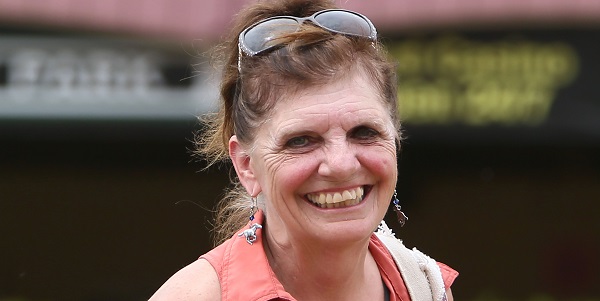By Katie Merritt
One only has to walk into Virginia Peters’ shedrow to know that they are in the barn of a true horse lover. Each horse has their head hanging over the webbing, patiently waiting for a loving pat. Where’s Jordan, the star of the six-horse barn, knickers knowingly from his stall next to the office for the peppermint that is surely in the trainer’s pocket, and paws impatiently until he receives it. “He’s a little spoiled,” she laughs as she un-wraps it.
Peters’ horses have called barn D3 at Canterbury Park home for the last 10 years or so, after she was bounced around the stable area for the first several years of her training career. She began training in 2000, but her main gig at the time was teaching family consumer science, which she did for 40 years in five different districts in Minnesota.
“Then, I was really crazy,” she remembered. “I would come to the track in the morning, feed my horses, arrange for them to go to the track, then I’d go to St. Paul and teach and then I’d come back and do it again.” Peters did that for about nine years until she retired from teaching in 2009.
Though she didn’t start training until later, horses were always a significant part of Peters’ life. She grew up on a farm in Rock County, Minnesota where she showed dairy cows and participated in 4H. “I started out with my dad’s pony that he had as a young man,” she explained, adding “No one really had time to teach me how to ride, so I’d use just a twine string bridle, and the only way I could get on was to climb on the windmill and jump on him.” When she went to college, she of course took her horses with her, and participated in the Rodeo Club and the Drill Team. “I’ve always been a little horse crazy,” she smiled.
Virginia always loved horses, but she didn’t grow up having anything to do with the racetrack. In fact, her first foray into racing was as an owner, and was purely by chance. She had a Quarter Horse mare that she took to breed to a paint stallion. While there, a scrawny little Thoroughbred filly caught her eye. “They had saved the mother because they wanted to breed her to their paint stallion,” said Peters, “But they didn’t like the baby at all, so I was able to buy her for $500.” Peters put her in training with Tony Rengstorf, and the scrawny little filly with a hernia that nobody wanted turned into Scotty’s Cashin In, a very successful mare. When the mare retired, Peters opted to keep her and breed her on her farm, along with a couple other mares that she had acquired along the way. “The mares started having foals, too many foals, and then my sister and my husband at the time, Woody, said ‘Well, if you want to do this you better get your trainers’ license, because there’s no way we can afford it!'” Virginia recalled. And so, a trainer was born.
Though she never worked as an assistant trainer for anyone, Virginia had gathered a lifetime’s-worth of equine knowledge and learned to train racehorses through trial and error. “It’s been a very expensive 17 years,” she joked, referencing the learning process. Over the years, she has trained for several different clients, but now mostly trains for family, and trains her own. The majority of the horses in her barn were raised on her 20 acre farm in Jordan, Minnesota. Where’s Jordan, the 4 year old gelding who is “pulling the weight of the whole stable” this year, with his two victories at Canterbury Park, is actually the grandson of that first fateful filly – Scotty’s Cashin In. Almost 20 years and three generations later, Peters is still reaping the benefits of the filly who started it all.
Virginia trains only at Canterbury Park, so that she can stay on her farm in Jordan with her horses and her family year-round. During the school year, she still occasionally substitute teaches, as well as stays busy sewing jockey’s silks for owners. “I’ve sewn most of the ones on the backside here,” she said, “I quit advertising because I’m as busy as I care to be,” she added with a laugh. Peters is passionate about horses and about what she does, but is certain that she wasn’t meant for a lifestyle that involves moving fairly regularly. Her horses get some time off after the Canterbury meet, and in February she sends them south to get a leg up on their training so that they can be ready to go when the meet starts in May.
Peters obviously enjoys her job and her relationship with her horses brings her back every summer. “You get a commitment with the horse itself,” she explains as she walks down the shedrow. “I just love them. Most of these horses in the barn, I had their mother, I was there when they were born, and I love to see them progress.” She thinks for a minute before adding, “It’s kind of like teaching in school. You see how they mature from Junior High to High School, to super status!” Be it students or horses, Virginia Peters is clearly a good teacher.
